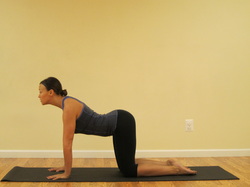 Cat/cows
Cat/cows In many cases, yoga can decrease back pain and discomfort for people with scoliosis by strengthening weak muscles, lengthening the spine and loosening tight muscles.
Standing postures will strengthen the legs to provide more support for the weight of the body and lessen the load on the spine. Warrior I and warrior II poses will both strengthen and stretch the legs. Stretching the legs and hips will also improve freedom of movement and posture.
Releasing the psoas muscles is another way to free the spine. A runner’s lunge with the back knee on the floor, release the wind pose, and pigeon pose will stretch the psoas.
Lengthening the spine to reduce the lateral curvature and create space between the vertebrae can help to alleviate pain. Seated forward bends, head-to-knee pose, and cat pose all lengthen the spine.
A strong core can prevent the back tightening from compensating for weak abdominal muscles. Yogic crunches and leg lifts will build strong abdominal muscles.
A gentle rotation of the spine in the triangle pose and half lord of the fishes pose stretches and strengthens the spine for proper alignment. Ironically, these poses can de-rotate the spine. Just be sure to focus on lengthening the spine when twisting toward the concave side of the spine. Concentrate more on the twist when turning toward the convex side of the spine.
Breathwork also plays an important role in yoga. In regards to scoliosis, send the breath into concave side of spine to stretch intercostals muscles to help create evenness on both sides of the chest.
When practicing any pose, be careful not to stretch to the point of pain as this type of movement is counter-productive. Check with a doctor before undertaking any new form of exercise.
Resources: Yoga for Scoliosis by Elise Browning Miller
Follow us on Facebook and Twitter. For yoga in Dunellen, NJ or yoga in Piscataway, NJ and yoga in other Central New Jersey areas, get in touch with me at Yoga Destiny.
Standing postures will strengthen the legs to provide more support for the weight of the body and lessen the load on the spine. Warrior I and warrior II poses will both strengthen and stretch the legs. Stretching the legs and hips will also improve freedom of movement and posture.
Releasing the psoas muscles is another way to free the spine. A runner’s lunge with the back knee on the floor, release the wind pose, and pigeon pose will stretch the psoas.
Lengthening the spine to reduce the lateral curvature and create space between the vertebrae can help to alleviate pain. Seated forward bends, head-to-knee pose, and cat pose all lengthen the spine.
A strong core can prevent the back tightening from compensating for weak abdominal muscles. Yogic crunches and leg lifts will build strong abdominal muscles.
A gentle rotation of the spine in the triangle pose and half lord of the fishes pose stretches and strengthens the spine for proper alignment. Ironically, these poses can de-rotate the spine. Just be sure to focus on lengthening the spine when twisting toward the concave side of the spine. Concentrate more on the twist when turning toward the convex side of the spine.
Breathwork also plays an important role in yoga. In regards to scoliosis, send the breath into concave side of spine to stretch intercostals muscles to help create evenness on both sides of the chest.
When practicing any pose, be careful not to stretch to the point of pain as this type of movement is counter-productive. Check with a doctor before undertaking any new form of exercise.
Resources: Yoga for Scoliosis by Elise Browning Miller
Follow us on Facebook and Twitter. For yoga in Dunellen, NJ or yoga in Piscataway, NJ and yoga in other Central New Jersey areas, get in touch with me at Yoga Destiny.

